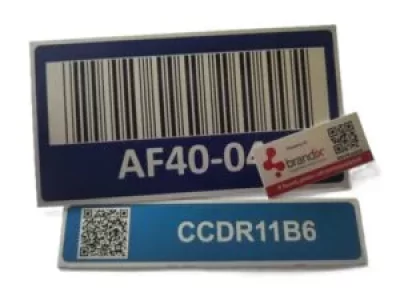Asset label manufacturing
Asset label manufacturing

Asset label manufacturing involves the production of durable, adhesive labels used to identify and track physical assets within an organization. These labels typically contain unique identifiers such as barcodes, QR codes, serial numbers, or asset tags.
Key Aspects of Asset Label Manufacturing:
- Materials: Common materials include:
- Vinyl: Durable and resistant to chemicals and moisture.
- Polyester: Strong and tear-resistant, often used for outdoor applications.
- Paper: Cost-effective for indoor use, but less durable.
- Metal: Robust and long-lasting, suitable for high-value assets.
- Printing Technologies:
- Digital Printing: Versatile for small to large orders, allows for customization and variable data.
- Flexographic Printing: Suitable for high-volume production of repetitive designs.
- Screen Printing: Ideal for large, bold graphics and vibrant colors.
- Customization: Asset labels can be customized with:
- Unique identifiers: Barcodes, QR codes, serial numbers, asset tags.
- Company logos and branding: Reinforces brand identity.
- Descriptive information: Asset type, location, purchase date.
- Warning or safety instructions: Promotes workplace safety.
- Durability: Asset labels are designed to withstand:
- Harsh environments: Extreme temperatures, moisture, chemicals.
- Abrasion and wear and tear: Daily handling and use.
- UV exposure: Sunlight and other sources of ultraviolet radiation.
- Adhesives: High-quality adhesives ensure the labels adhere securely to various surfaces.
Applications of Asset Labels:
- IT Equipment: Laptops, desktops, servers, peripherals.
- Medical Devices: Hospital beds, diagnostic equipment, surgical instruments.
- Industrial Machinery: Manufacturing equipment, tools, vehicles.
- Office Furniture: Desks, chairs, filing cabinets.
- Library Books: Cataloguing and tracking.
Benefits of Asset Label Manufacturing:
- Improved Asset Tracking: Efficiently locate and manage assets.
- Reduced Loss and Theft: Minimize losses due to misplaced or stolen assets.
- Streamlined Inventory Management: Optimize inventory control and reduce costs.
- Enhanced Security: Improve security measures and protect valuable assets.
- Data Collection and Analysis: Facilitate data collection for asset management purposes.
By providing clear identification and tracking capabilities, asset labels play a crucial role in optimizing asset management processes and improving overall operational efficiency.
Asset Tags, Labels, and Stickers: A Breakdown
While often used interchangeably, asset tags, labels, and stickers each have distinct characteristics and applications:
1. Asset Tags
- Purpose: Primarily used for identifying and tracking physical assets within an organization.
- Materials: Typically made from durable materials like metal (aluminum, stainless steel), plastic (polyester, vinyl), or even paper.
- Features: Often include unique identifiers such as barcodes, QR codes, serial numbers, or RFID chips.
- Attachment: Can be attached using adhesive, screws, or other methods.
- Durability: Designed to withstand harsh environments and resist wear and tear.
2. Asset Labels
- Purpose: Similar to asset tags, used for identification and tracking, but often with a focus on providing more information.
- Materials: Typically made from adhesive materials like vinyl, polyester, or paper.
- Features: Can include barcodes, QR codes, serial numbers, asset descriptions, company logos, and other relevant information.
- Attachment: Primarily attached using adhesive.
- Durability: Varying levels of durability depending on the material used.
3. Stickers
- Purpose: Generally used for a wider range of applications, including decoration, branding, and information dissemination.
- Materials: Typically made from paper or vinyl.
- Features: Can include text, graphics, images, and logos.
- Attachment: Attached using adhesive.
- Durability: Generally less durable than asset tags and labels
- Asset tags are robust and primarily focused on unique identification for tracking purposes.
- Asset labels provide more detailed information while still maintaining tracking capabilities.
- Stickers are versatile and serve a broader range of purposes beyond asset tracking.
The choice between asset tags, labels, and stickers depends on the specific needs and requirements of the application.
The primary difference between asset tags and asset labels lies in their material composition and intended use:
Asset Tags:
- Material: Typically made from durable materials like metal (aluminum, stainless steel), plastic (polyester, vinyl), or even paper.
- Purpose: Primarily for identification and tracking of physical assets within an organization.
- Features: Often include unique identifiers such as barcodes, QR codes, serial numbers, or RFID chips.
- Durability: Designed to withstand harsh environments and resist wear and tear.
Asset Labels:
- Material: Typically made from adhesive materials like vinyl, polyester, or paper.
- Purpose: Similar to asset tags, used for identification and tracking, but often with a focus on providing more information.
- Features: Can include barcodes, QR codes, serial numbers, asset descriptions, company logos, and other relevant information.
- Durability: Varying levels of durability depending on the material used.
In essence:
- Asset tags prioritize durability and unique identification for long-term tracking.
- Asset labels offer more flexibility in terms of information and customization, but may have lower durability depending on the material and application.

We custom manufacture for Industrial applications Anodized Aluminum and Polymer based Name Plates, Fascia Panels, Mimic Panels , Overlays, Decals, Safety Signage, Calibration Labels, Asset Management Labels, and lots more.
